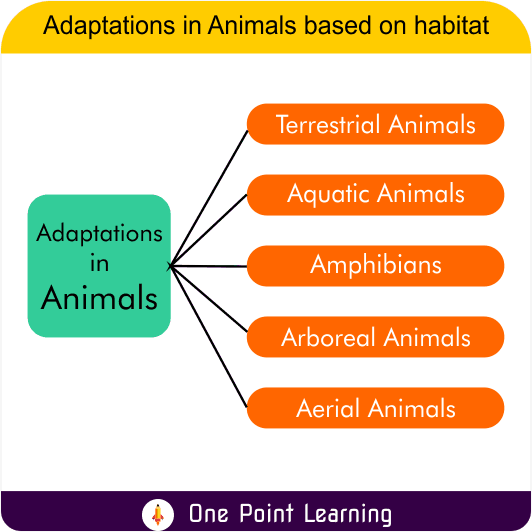Adaptation in animals are special traits they develop over long periods to survive in their habitats – like superpowers! In this lesson, students will explore physical, behavioral, and sensory adaptations using fascinating examples, short stories, and printable worksheets.
Adaptations are long-term changes in animals that help them find food, stay safe, and live better in their homes (habitats). Animals live in places like forests, deserts, polar areas, water, or trees—and each habitat requires unique survival strategies.
By studying the amazing ways in which animals have adapted to their environments, students in class 4 can gain a deeper knowledge of the diversity of the animal kingdom.
Adaptation in Animals Worksheet
In Class 4 Science, the chapter on adaptation in animals introduces children to the unique ways animals adjust to their surroundings. Whether it’s the camel’s hump or a penguin’s webbed feet, every feature has a purpose!
Download our adaptation in animals Class 4 worksheets PDF with answers for practice and revision. Each worksheet contains various question types like fill in the blanks, true or false, MCQs and question – answers.
Read Also:
Free Science worksheets for Class 4
NCERT Hindi Worksheets for Class 4
Maths Worksheets for class 4
What is an adaptation in animals?
Adaptations are like special powers or changes that animals develop over a long time to help them survive in their habitats or environment. The natural home of an animal is called habitat from where it can obtain food, shelter, build homes and reproduce.
Type of adaptations in animals
Every animal has its own unique adaptations that make it perfectly suited for its environment. The main types of adaptations are Physical, Behavioral and Sensory.
Physical Adaptations
- Camouflage: Blending in – Many animals have the ability to blend in with their surroundings to avoid detection by predators like chameleons changing color.
- Body Structures: Animals living in water, such as ducks and otters, have webbed feet that allow them to swim more efficiently; polar bears have thick fur to protect from cold.
- Teeth and claws: Many animals like lions and tigers have sharp teeth and claws, that they use for hunting and defending themselves against predators.
- Special Features: Camels store fat and water in humps for desert survival.
Behavioral Adaptations
- Hibernation: Some animals like frog and bears hibernate when food is scarce. They lower their metabolic rate and enter a state of dormancy to conserve energy.
- Nocturnal Habits: Desert animals (e.g., desert foxes) are active at night to avoid heat.

Adaptations based on Habitat
Animals have amazing ways to fit into their environments for survival. Let’s explore how animals adapt to their habitats to survive.
On the basis of their habitat, animals can be divided into five major groups: terrestrial, aquatic, amphibians, arboreal and aerial animals.
Terrestrial Animals
Terrestrial adaptations can further be classified into Forest, Desert and Polar regions.
Forest animals
Animals like monkeys and sloths have adapted to climb trees, whereas some animals have special teeth for eating grass efficiently. Some animals have developed special senses to hunt and protect themselves. On the other hand, some animals have adapted for speed to chase down prey. Tigers, lions, elephants, cows, horses, monkey, dogs and fox are some examples of forest animals.
Desert animals
Desert animals adapt to save water, protect from hot and cold weather, as well as change color to hide themselves. Sand-colored lizard, have skin that matches the color of the sand to protect from other animals. Desert rats and foxes are active during night only. Camels, have special humps to store water, to survive in a dry habitat.
Polar animals
The poles are cover with ice and thus are the coldest place on the Earth. Artic fox, Seals, Polar Bear and penguin are some animals found in polar regions. Polar bears and seals have thick fur to keep them warm. While Penguins have webbed feet to help them swim.
Aquatic Animals
Animals that live in water are called aquatic animals. They have unique adaptations that help them to survive in water. These adaptations in animals can be:
- Gills: Aquatic animals, like fish, have gills to absorb oxygen from the water. Gills are like their underwater lungs, allowing them to breathe.
- Fins: These fins and flippers help animals to move through the water with speed and agility. For example, dolphins have powerful flippers for swimming gracefully.
- Streamlined Bodies: To reduce water resistance, aquatic animals, such as sharks and seals, have streamlined bodies. This shape allows them to glide efficiently through the water.
- Webbed Feet: Aquatic birds like ducks and penguins have webbed feet that act like paddles for swimming.
Adaptation in Animals Class 4 Questions and Answers
Q1. What is adaptation?
Ans. Adaptation is a special feature or behavior that helps an animal live in its environment.
Q2. Name two animals that live in the desert and their adaptations.
Ans.
Camel – Stores water in its hump.
Desert fox – Has large ears to keep cool.
Q3. Why do polar bears have white fur?
Ans. To blend in with the snow (camouflage) and stay warm.
Q4. What is the use of webbed feet?
Ans. Webbed feet help animals like ducks and frogs to swim easily.
Q5. Which animals hibernate in winter?
Ans. Bears and frogs.
Q6. What is the importance of adaptation in animals?
Ans. Adaptation helps animals survive in their environment by protecting them from danger, helping them find food, and adjusting to weather changes.
Q7. How does a camel survive in the desert?
Ans. A camel has a hump to store fat, long eyelashes to protect its eyes from sand, and wide feet to walk on sand easily.
Q8. What is camouflage? Give one example.
Ans. Camouflage is the ability to blend with the surroundings. A tiger uses its stripes to hide in tall grass.
Q9. What is migration? Give one example.
Ans. Migration is the movement of animals from one place to another, usually for food or to escape the cold. Birds like the Arctic Tern migrate during winter.
Q10. Why do animals living in cold regions have thick fur?
Ans. Animals in cold areas like the polar bear have thick fur to keep them warm in freezing temperatures.
Q11. Describe the adaptations found in aquatic animals.
Ans. Aquatic animals like fish have gills to breathe underwater and fins to swim. Their bodies are streamlined, which helps them move easily in water. Animals like ducks have webbed feet to paddle and swim.
What do you get in Science worksheets for Class 4 PDF
- Printable Science Worksheet in A4 PDF format.
- 100% Free to download and easy to print at home.
- Answer key available at the last page.
- Wholly based on latest Syllabus and pattern.
- Progressive approach with increasing difficulty level.
Learning about adaptation in animals (Class 4) helps children understand how animals survive in the world around them. It also builds curiosity and respect for nature. With the help of real-life examples, questions and answers, and Class 4 adaptation worksheets, students will easily grasp this important science concept.
So don’t forget to download the adaptation in animals Class 4 PDF and try out the fun exercises!




Thank you very much for the worksheets posted , its very useful for my students’ learning about adaptation and ecosystem. Hoping there are more to come for some other lessons especially science.
Very much appreciated.
Thank you very much,
Cecil U. Biagtan